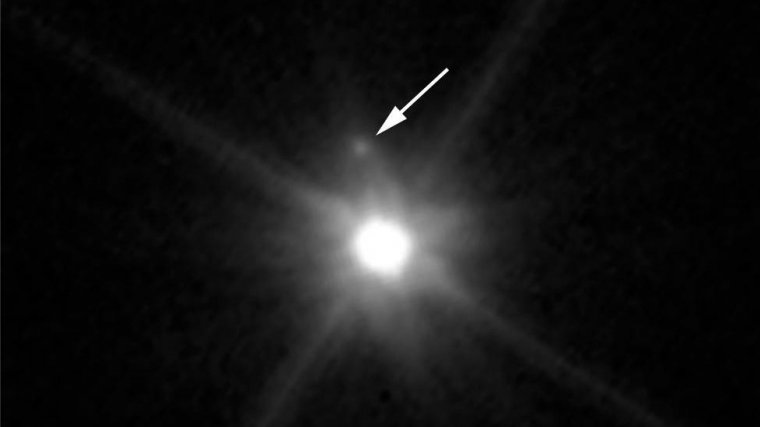| News / Space News |
Hubble Discovers Moon Orbiting the Dwarf Planet Makemake
NASA | APRIL 30, 2016
Peering to the outskirts of our solar system, NASA’s Hubble Space Telescope has spotted a small, dark moon orbiting Makemake, the second brightest icy dwarf planet — after Pluto — in the Kuiper Belt.

This Hubble image reveals the first moon ever discovered around the dwarf planet Makemake. ![]()
The moon — provisionally designated S/2015 (136472) 1 and nicknamed MK 2 — is more than 1,300 times fainter than Makemake. MK 2 was seen approximately 13,000 miles from the dwarf planet, and its diameter is estimated to be 100 miles across. Makemake is 870 miles wide. The dwarf planet, discovered in 2005, is named for a creation deity of the Rapa Nui people of Easter Island.
The Kuiper Belt is a vast reservoir of leftover frozen material from the construction of our solar system 4.5 billion years ago and home to several dwarf planets. Some of these worlds have known satellites, but this is the first discovery of a companion object to Makemake. Makemake is one of five dwarf planets recognized by the International Astronomical Union.
The discovery may have solved one mystery about Makemake. Previous infrared studies of the dwarf planet revealed that while Makemake’s surface is almost entirely bright and very cold, some areas appear warmer than other areas.
Astronomers had suggested that this discrepancy may be due to the sun warming discrete dark patches on Makemake’s surface. However, unless Makemake is in a special orientation, these dark patches should make the dwarf planet’s brightness vary substantially as it rotates. But this amount of variability has never been observed.
These previous infrared data did not have sufficient resolution to separate Makemake from MK 2. The team’s reanalysis, based on the new Hubble observations, suggests that much of the warmer surface detected previously in infrared light may, in reality, simply have been the dark surface of the companion MK 2.
There are several possibilities that could explain why the moon would have a charcoal-black surface, even though it is orbiting a dwarf planet that is as bright as fresh snow. One idea is that, unlike larger objects such as Makemake, MK 2 is small enough that it cannot gravitationally hold onto a bright, icy crust, which sublimates, changing from solid to gas, under sunlight. This would make the moon similar to comets and other Kuiper Belt Objects, many of which are covered with very dark material.
YOU MAY ALSO LIKE




